There are so many reasons to cook more wild venison.
First, it’s hugely nutritious, boasting higher protein levels than other red meat sources and more of the hard-to-find minerals zinc and selenium.
It is also very lean, meaning we don’t need to worry about saturated fats. (FYI - I don’t worry about saturated fats.)
Second, it is actually sustainable.
Yes, sustainable red meat exists. Venison is perhaps on top of that list.
The thing with deer in the UK is they don’t have a natural predator. Thanks to this, coupled with an abundant supply of food and the introduction of non-native deer species, we have somehow ended up with a few too many of them on our shores.
Sadly, they love to munch on trees which is damaging woodlands and all the lovely woodland-dwelling species that live in those environments.
In a nutshell, too many deer means fewer trees, which is bad news, so we cull deer each year.
Cue a supply of sustainable, highly nutritious protein.
Last but not least, venison is delicious.
I may be biased but this recipe is super tasty.
Think a rich ragu with chunks of meat that cooks in 30 minutes flat.
In fact, you don’t need to cook venison all that long full stop, thanks to its low fat content.
Top tip: check the recipe notes after the methods section if you aren’t familiar with “chefy” terms.
Ingredients to feed 2
300g of diced wild venison (it’s in many supermarkets now)
1 onion, finely diced
1 stick of celery, finely diced
5-6 chestnut mushrooms, roughly sliced
2 cloves of garlic, crushed or finely diced
1 large carrot, blended into a puree (blending the carrot makes a sweeter, thicker sauce)
1 bay leaf
300ml passata
1 glass of good quality red wine. I used an organic Italian Primitivo.
Sea salt and black pepper for seasoning
Any good quality oil for cooking, I used cold-pressed rapeseed oil
Pasta & greens to serve.
I used pappardelle pasta and kale.
Method
1. Add a couple of tablespoon of oil to a large saucepan on a medium-low heat.
2. Pop in your onions & celery immediately and allow them to saute until they are soft. Approximately 10 minutes.
3. Turn the heat up to high.
4. Add the venison and cook for a couple of minutes until it is beginning to colour. You’ll need to give the pan a good stir to stop anything from catching.
5. Pour in the wine and let it cook until almost all of it is gone. It’ll bubble away quickly.
6. Stir in the mushrooms and garlic.
7. Turn the heat down to low, add the carrot puree, bay leaf and passata and season it well with sea salt and black pepper.
8. Let everything bubble away slowly on a low heat for 20 to 30 minutes until the sauce has reduced and the meat is tender. If the sauce is looking too dry then add a splash of water.
9. Taste the sauce and add more salt & pepper if needed.
10. Serve with pasta and a side of greens.
Recipe Notes
Finely diced onion & celery = the smallest squares you can humanly chop onions & celery into.
Passata is a “sieved” version of chopped tomatoes. Think smoother chopped tomatoes. Available from most supermarkets and usually lives next to chopped tomatoes.
If you need to feed more than 2 people, simply multiply the quantity of ingredients.
Pureeing a raw carrot adds natural sweetness to your ragu. If you can’t be bothered to wash a blender (or don’t have one) then dice the carrot and add it to your pan at the same time as the onions/ celery.





